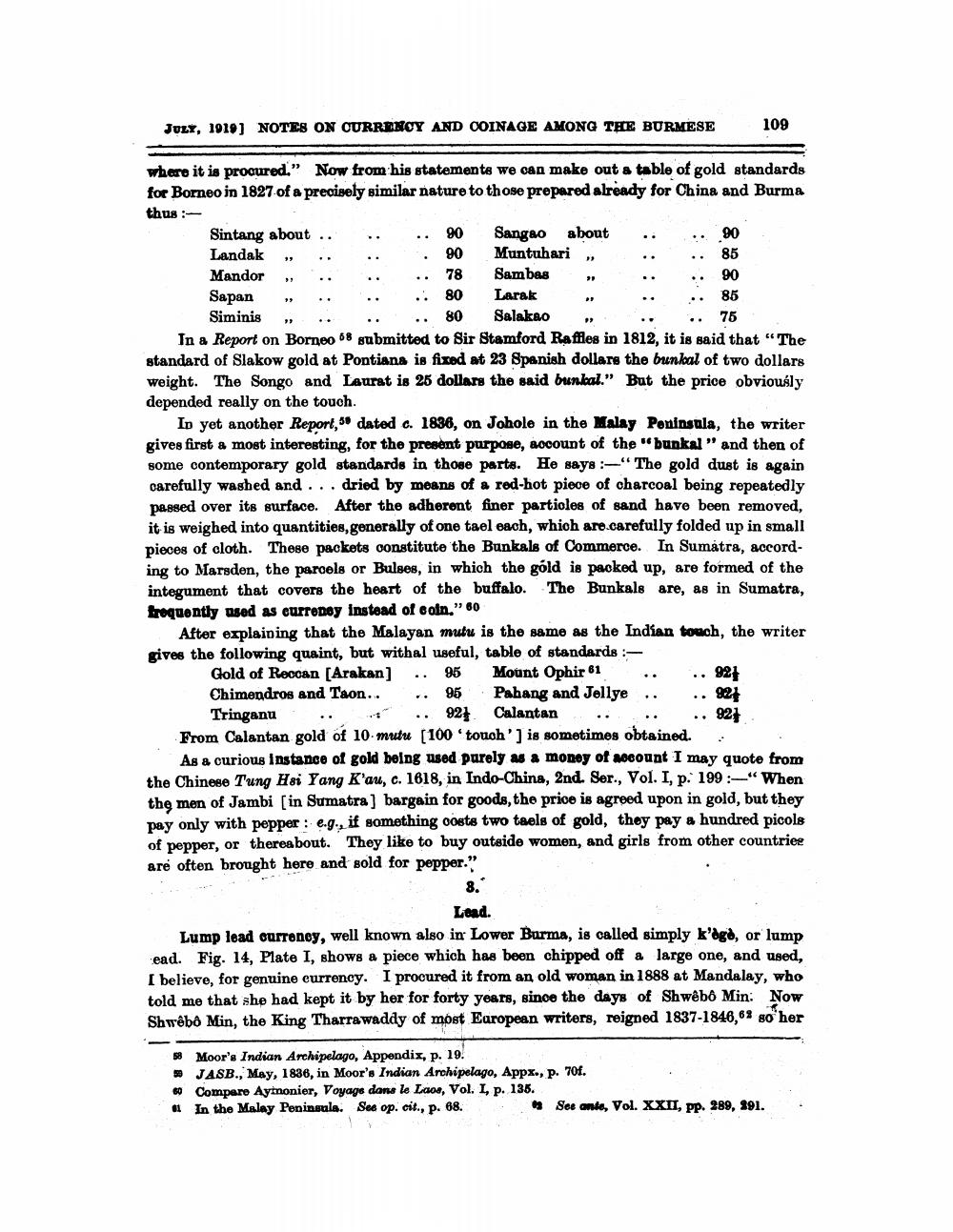________________
JULY, 1919] NOTES ON CURRENOY AND COINAGE AMONG THE BURMESE
109
75
where it is procured.” Now from his statements we can make out a table of gold standards for Borneo in 1827 of a precisely similar nature to those prepared already for China and Burma thus :Sintang about ..
Sangao about Landak
Muntuhari ,
.. 85 Mandor . .. .. .. 78 Sambas
. .. 90 Sapan . . . . . . 80 Larak
. .. 85 Siminis .. .. .. .. 80 Salakao
to .
.. .. 76 In a Report on Borneo 68 submitted to Sir Stamford Raffles in 1812, it is said that "The standard of Slakow gold at Pontiana is fixed at 23 Spanish dollars the bunkal of two dollars weight. The Songo and Laurat is 25 dollars the said bunkal." But the price obviously depended really on the touch.
In yet another Report, 56 dated c. 1836, on Johole in the Malay Peninsula, the writer gives first & most interesting, for the present purpose, sooount of the "bunkal" and then of some contemporary gold standards in those parts. He says "The gold dust is again carefully washed and ... dried by means of a red-hot piece of charcoal being repeatedly passed over its surface. After the adherent finer partioles of sand have been removed, it is weighed into quantities, generally of one tael each, which are carefully folded up in small pieces of cloth. These packets constitute the Bunkals of Commerce. In Sumatra, accord ing to Marsden, the paroels or Bulses, in which the gold is packed up, are formed of the integument that covers the heart of the buffalo. The Bunkals are, as in Sumatra, troquently used as currenoy Instead of coln." 60
After explaining that the Malayan mutu is the same as the Indian touch, the writer gives the following quaint, but withal useful, table of standards :
Gold of Roocan (Arakan) .. 95 Mount Ophir 61 .. .. 921 Chimendros and Taon.. .. 95 Pahang and Jellye .. .. 92 Tringanu ..
.. 92 Calantan .. .. .. 927 From Calantan gold of 10-mutu (100 'touch') is sometimes obtained. . .
As a curious instance of gold being used purely as a monoy of socount I may quote from the Chinese Tung Hsi Yang K'ar, c. 1618, in Indo-China, 2nd. Ser., Vol. I, p. 199 :-“When the men of Jambi (in Sumatra) bargain for goods, the prioe is agreed upon in gold, but they pay only with pepper : e.g., if something costs two taels of gold, they pay a hundred picols of pepper, or thereabout. They like to buy outside women, and girls from other countries are often brought here and sold for pepper."
8.
Lead Lump lead curroney, well known also in Lower Burma, is called simply k'ogė, or lump ead. Fig. 14, Plate I, shows a piece which has been chipped off a large one, and used, I believe, for genuine currency. I procured it from an old woman in 1888 at Mandalay, who told me that she had kept it by her for forty years, sinoe the days of Shwebo Min: Now Shwebo Min, the King Tharrawaddy of most Earopean writers, reigned 1837-1846,6% so her
5 ►
Moor's Indian Archipelago, Appendix, p. 19. JASB., May, 1836, in Moor's Indian Archipelago, Appx., p. 70. Compare Aytnonier, Voyage dans le Laos, Vol. I, p. 136. In the Malay Peninsula. Ses op. cit., p. 68.
See ante, Vol. XXII, pp. 289, 291.
.




